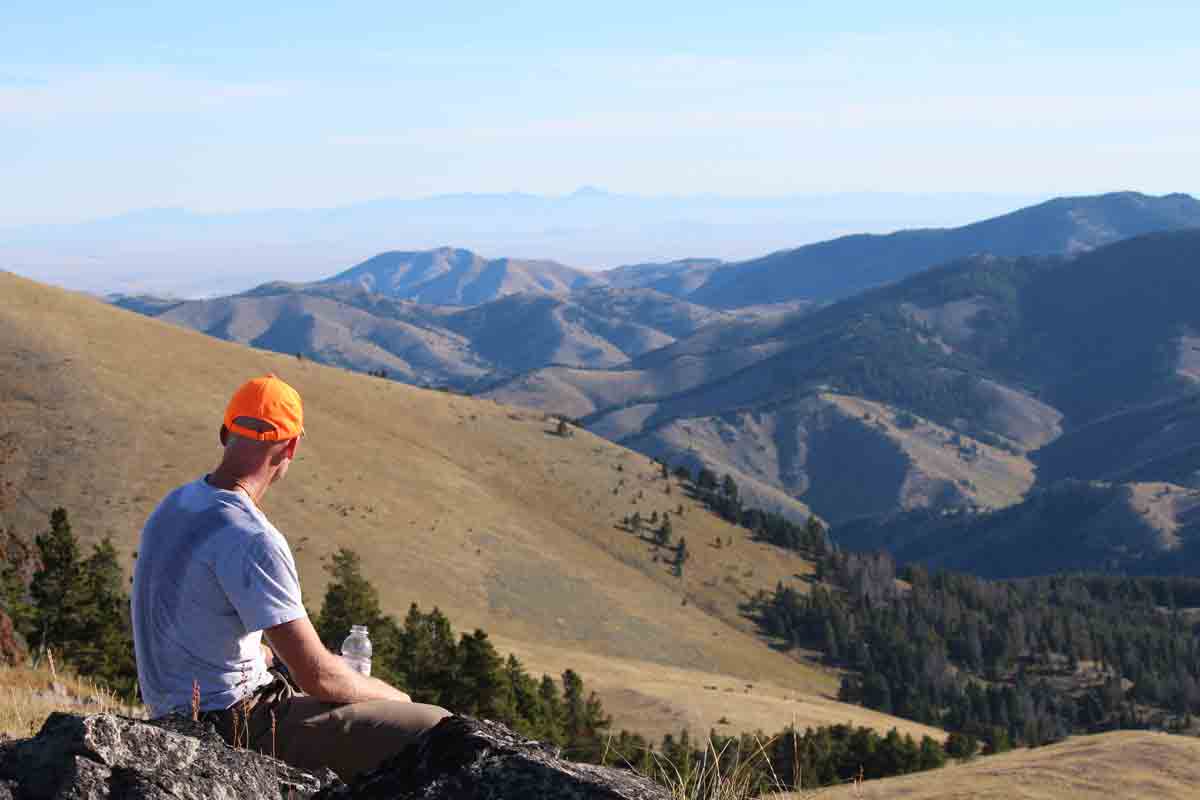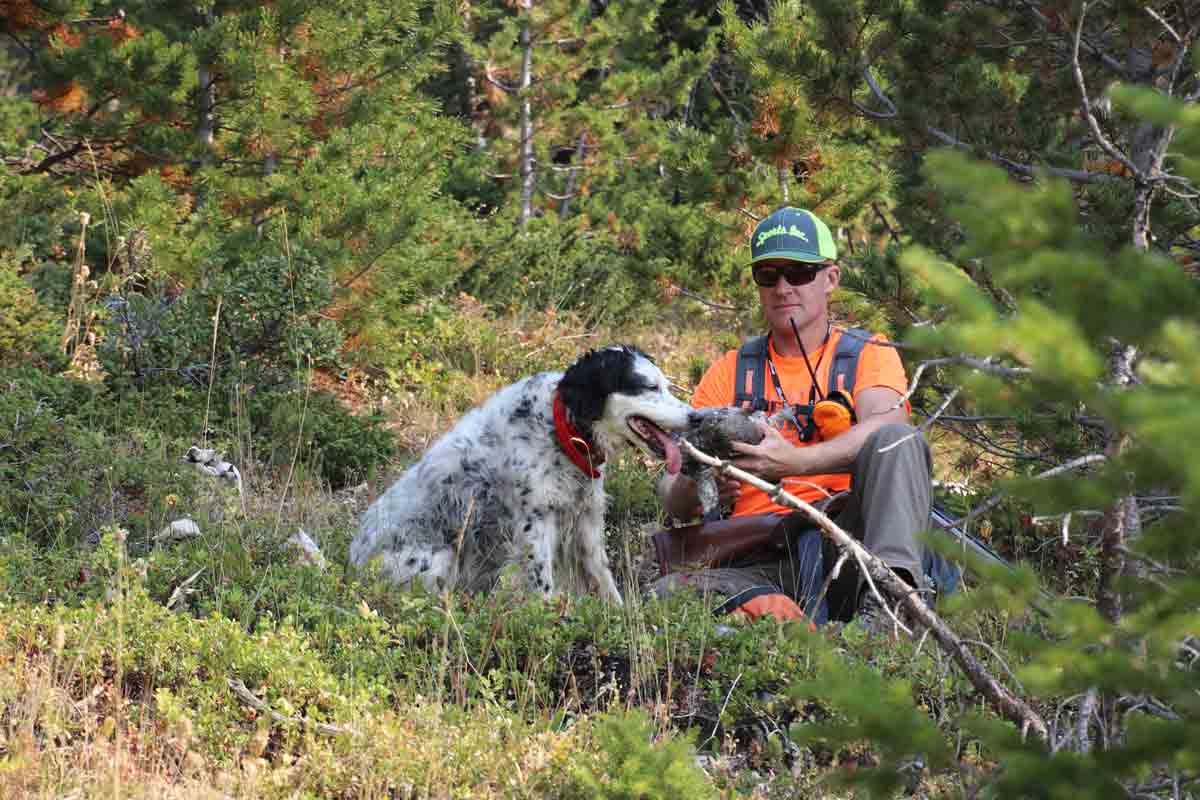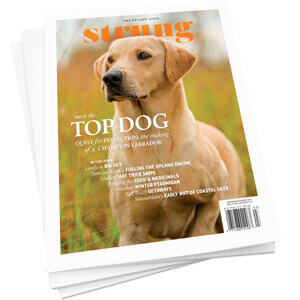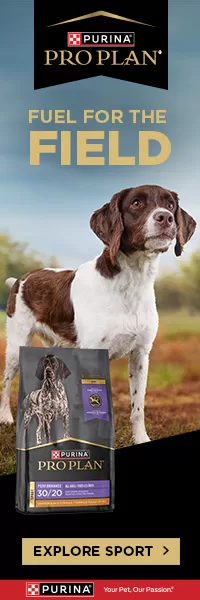Fueling the Upland Engine: Bird Dogs and the Food That Fuels Them
words by Jamison Allen
photos by Matt Soberg
I sat in the grass in the shade of a tree near the parked truck. Beside me was my backpack, bulging with gear. In front of me was the steep slope of pine trees, straight up to the bald spot on top of the mountain. I’m not in the Midwest anymore, I thought to myself. I was in Montana, and it was time to ascend. I reached down and tied my boots tighter than I ever had before.
The game plan: Chase blue grouse for a couple days in a location accessible only by foot. Beautiful views and challenging wingshooting await the intrepid hunter who can make it to where blues eat bugs in the bald, grassy fields on the edges of their piney hiding spots—as high as you can possibly get on the mountain.
I am, without question, a flatlander. Although the ruffed grouse coverts of my home base come with their own perils—wolves, porcupines, and vast and bewildering expanses of Northwoods—they are on relatively flat, soft ground. To condition myself for the steep terrain of this Western hunt–difficult to do on the flat ground of home–I grudgingly embraced the stair stepper. Aerobic exercise and leg lunges became a part of my daily routine for that summer before the season.
Blues are a pleasure to hunt with pointing dogs–but if you plan to hunt the contours of the high country, where the turf is hard and rocky, you aren’t the only one who needs conditioning. We ran miles on gravel to condition my dogs and harden their pads. Even then, when we arrived and hunted the hard ground, I ran the dogs with strengthened cordura booties–meant for sled dogs–as a preventive measure. Pad cuts and abrasions on the mountain can end a hunt all too quickly.
Our packs were loaded to the gills with tents, sleeping gear, and the food we carried to our destination—admittedly not part of a typical blue grouse hunt. But we had reasoned that if we camped near where the blues first left their roosts to feast on bugs, then we’d be fresh to hunt right from the tent rather than face an early-morning climb.
The problem, of course, was water—or more specifically, the lack thereof on top of the mountain. We’d have to pack our own hydration–for men and dogs–for two or three days, which would hamper our climbing ability and the duration of our hunt. The dogs were outfitted like miniature pack mules, and they carried their own water on the initial climb to camp.
With packs, guns, and drinks–and with the dogs packing, too–we began our ascent to the higher elevation and thinner air.
 We arrived at our campsite just as the setting sun was aggressively flirting with the horizon. We set the tent, and I was surprised to see my hunting buddy, whose bags had been heavy enough, pull a couple of cans of Mountain Man Scotch Ale from his pack. I certainly appreciated the additional effort in that moment. “Well played, friend. Well played,” I said as I popped the top.
We arrived at our campsite just as the setting sun was aggressively flirting with the horizon. We set the tent, and I was surprised to see my hunting buddy, whose bags had been heavy enough, pull a couple of cans of Mountain Man Scotch Ale from his pack. I certainly appreciated the additional effort in that moment. “Well played, friend. Well played,” I said as I popped the top.
We sat to rest with our bird dogs and simply enjoyed the view from the top of the world in silence. As I reached down and unstrapped the pack from the back of my setter, I wondered, not for the first time, how these dogs can run many miles more than hunters walk. They climb the crags, ridges, and rocks without boots. Where I can barely keep up, they are like finely tuned machines, with almost single-minded focus in pursuit of game birds.
How do these dogs do it?
***
“The science of feeding a performance dog goes beyond the calories or amount of food you feed,” says Russ Kelley, MS, who is a part of the leadership team for the Pet Health Nutrition Center [JOE: Please note that I changed this to reflect the sponsor comment, BUT the comment spelled his name “Kelly” (as opposed to Kelley, which was in the article and online) AND I’m not sure that’s the correct title of this center (though I’m having trouble tracking this down at all at the Mars Petcare site. Just sayin’…] and leads all of the Eukanuba service, working, and sporting dog research. “Performance dogs have a job to do, and to perform at their best, they need both the right amount of energy and the right balance of nutrients.”
All nutrients are important for the optimal health and performance of these hardworking dogs—protein, lipids, minerals, carbohydrates, vitamins, and water—but the exact amounts needed of each will vary from dog to dog, activity to activity, and life stage to life stage. Physiological demands—physical, mental, and environmental—are all stressors that influence a dog’s nutritional needs.
During an event of continuous activity and elevated stress—such as a blue grouse hunt—performance dogs may burn more than 2,400 calories per day and put significant strain on their muscles and joints. In such situations, bird dogs require a carefully increased intake of dietary energy sources (lipids, carbohydrates, and proteins). Limit the volume of intake to five or six cups a day; in other words, you need a dog food that provides the requisite energy in the correct volume.
 Many believe that protein is the main energy driver in dog food. “In fact,” reports Kelley, “fat in the diet is the most concentrated form of energy from all nutrients. For performance dogs, a fat level of 20 percent is recommended.” In addition, protein is still a key component to a performance dog’s diet, along with the right amounts of vitamins, minerals, and water.
Many believe that protein is the main energy driver in dog food. “In fact,” reports Kelley, “fat in the diet is the most concentrated form of energy from all nutrients. For performance dogs, a fat level of 20 percent is recommended.” In addition, protein is still a key component to a performance dog’s diet, along with the right amounts of vitamins, minerals, and water.
The best nutritional solution for your dog is a balance between all nutrient categories that takes into account the activity level of the dog at the time. “For example,” says Kelley, “Eukanuba’s performance diets–30 percent protein and 20 percent fat–contain a tailored blend of all nutrients to provide sustained energy for performance dogs to allow them to perform at their peak, time and time again.”
Hydration is also a key factor: Performance dogs need a water intake of at least three times food intake (for example, 12 cups of water to four cups of food). A 50- to 75-pound dog can lose from one-half to two gallons of water (or more) per hunt day.
Understand the nutrients in your bird dog’s food, and choose food that comes from a reputable source–a company committed to science-based pet nutrition. With decades of experience in dog food research, Kelley brings his expertise and guidance to Royal Canin and Eukanuba to create science-based food that fuels our performance dogs. Look for a company like Eukanuba that has researched and field tested its food for years to develop scientifically formulated diets for peak nutrition in sporting dogs—with quality standards that exceed the requirements of the Association of American Feed Control Officials.
***
As I crushed my can, ready to hit the tent and contemplating the next day’s hunt with excitement, I gazed with wonder and appreciation at the bird dog at my side. He was as eager to hunt as I was. Hydrated and well fueled, he was ready to roll for days on the mountain. Next time, before heading to field, forest, or mountain, do your due diligence and research your sporting dog’s food. His well being and the success of your hunt may depend upon it.



